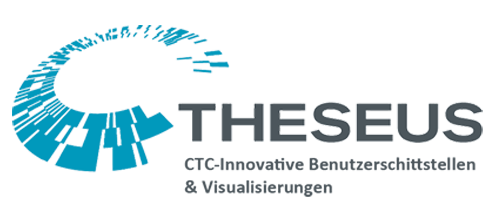THESEUS-CTC Innovative User Interfaces and Visualizations

Semantic Technologies and semanticly annotated informations open a broad spectrum of new possibilities for the discovery and transfer of knowledge. Every bit of information has connections to every other information from the chosen domain. Data which was processed in this form can be searched faster and represented in a form which is much closer to human needs and habits and thus enables the user to a natural and more efficient way of aquireing and understanding new concepts and relations hidden in the data. one challenge in this context is the the adequate visualization of this information. How can semantic informations be visualised to ensure a maximal efficiency? How can we use the characteristic properties of an ontology to improve search, aquirement and transfer of information?
The THESEUS CORE Technology Cluster for innovative User Interfaces and Visualisation as a part of THESEUS Research project concentrates on the efficient graphical representation and intuitive interaction of semantics and with help of semantics. Furthermore, we involve techniques from Visual Analytics to enable adequate search in raw data.
The THESEUS Core Technology Cluster (CTC) for semantic visualization and innovative user interfaces researches techniques and concepts for the effective presentation of semantic data to the user. Particularly attributes and characteristics of ontologies are investigated, which are relevant for visualization of information. The research in CTC is based on user centred approaches, where the users are provided with user-adapted intuitive interfaces on the basis of the developed core technology. Being the face of the THESEUS program, the Core Technology Cluster provides adaptable knowledge visualization approaches for several use cases of the THESEUS program. These approaches provide the ability to adapt the visualization to specific contexts or users. Therefore, a modular graphical user interface (GUI) for the different users and their individual characteristics and needs will be developed. This provides a basis for the configuration and personalisation of the graphical user interfaces as foreseen in the requirements of THESEUS. To achieve this goal, a modular GUI (Graphical User Interface) framework will be the basis for the different requirements of the project. Furthermore, a user experience (UX) design methodology for the visualizations and the interfaces will be suggested to enable a systematic, user centred and standardized adaptation to the components.
The THESEUS Core Technology Cluster for semantic visualization researches and defines in conjunction with automatic adaption to the user different graphical primitives, which are on the one hand relevant for the user and his perception and on the other hand take the semantic character of information in account.
The design and concept of the several user interfaces and visualization for THESEUS are critical for the acceptance of the developed technologies. The user interface can be seen as the most important aspect of an information system. The user interface is typically evaluated on different contents, business goals, supported context, user needs and user behaviour. Besides the design and concept of semantic visualizations based on the existing ontology the Core Technology Cluster additionally develops methods to explore raw data sets. The information hidden in the raw data is extracted by visual analysis methods from the field of Visual Analytics.
